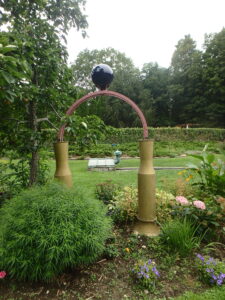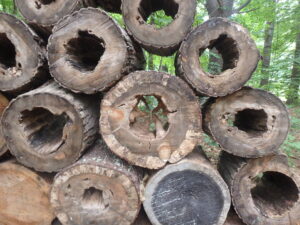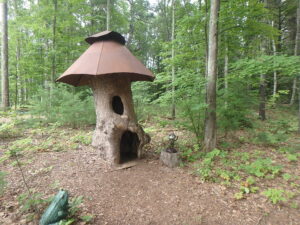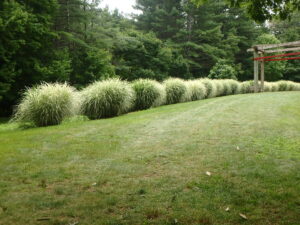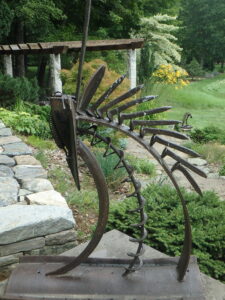Gardening in March
Posted on Friday, March 14, 2025 · Leave a Comment
Whether March came in like the proverbial lion or lamb for you, March is the time when you need to pay more attention to your houseplants. Instead of watering every Sunday, you probably need to water most things twice a week – except for cacti and a few plants that thrive in dry soil. But rosemary? It’s so easy to kill now. The sun is hotter, roots are growing, and they need more water. Don’t keep the soil soggy, but poke your fingers into the soil more often and make sure it’s not Arizona arid. A dry rosemary is a dead rosemary.
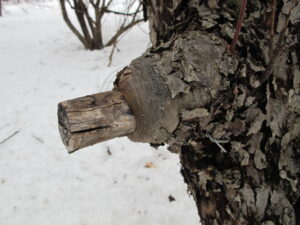
Don’t leave stubs, they have to heal back to branch collar
Although March is the time farmers tend to prune their fruit trees, I am waiting a bit. We still have too much snow to easily move around carrying ladders. Pruning experts will tell you that you can prune fruit trees any month of the year, something I have found to be true. But let’s go over a few rules for pruning.
Use sharp tools. A good pair of hand pruners, some loppers and a pruning saw are all you need. I don’t like bow saws – they can’t get into tight places. Know where to cut. Don’t cut branches flush with the trunk or a big branch. Each branch has a “collar” that should be left. This is the bulge where it heals. But don’t leave long stubs when you remove a branch. They will not heal properly, and look awful. Remove dead branches first.
Never remove more than about a quarter of the leaf-producing branches. Leaves are the engine that drive growth and flower and fruit production. Remove water sprouts each year or two. These start as pencil thin shoots growing straight up, but will get big and clutter up the interior of the tree. Remove branches that are rubbing or crossing others, or are growing in towards the center of the tree. Remember: sunlight should be able to reach every leaf. Open up the interior so this is possible.
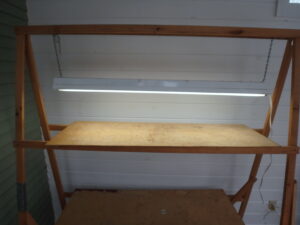
Homemade A frame plant stand for starting seedlings
March is also the time I start planting seeds indoors. Onion family seeds and peppers, hot and sweet, can be started now. Artichokes and cardoon I start early, but tomatoes I don’t start until around April 10. That will give them 8 weeks to be ready to go outside in mid-June.
Actually, it is much easier to order onions as bareroot plants sold in bunches of 50, each a few inches long and ready to start growing in the ground in May. Johnny’s Select Seeds and others sell them, and your local nursery may sell onions in 6-packs, each cell with 4 to 6 seedlings. The main advantage to starting onions or tomatoes by seed is that you get a much wider choice in what you grow.
If you want to start plants indoors, you will need some lights. Yes, some people try a sunny window, but they generally get lanky plants leaning toward the sunshine. Kits with LED or fluorescent lights are sold at garden centers and online. I built my own, a simple A-frame wooden structure that has two plywood shelves and supports 4-foot lights. It can accommodate up to 12 flats of seedlings if I put some on the floor.
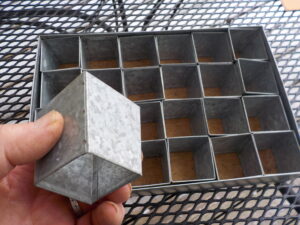
Metal planting cells from Gardeners Supply
Next you need 6-packs of either plastic (like the ones you get when you buy veggies or annuals at the nursery) or re-usable metal or heavy duty plastic ones. In my efforts to reduce my use of single-use plastic, I have switched over to re-usable plant cells. Yes, they are more expensive, but they last forever. In any case, get bigger cells, not smaller ones. Your babies are going to grow in them for 8 weeks or more and need plenty of room for roots.
You can buy seed starting mix, but if you do a lot of plants (as I do), it can get expensive. So you can mix the potting mix with good quality compost if you have it, or you can buy it. Seed starting mixes don’t have much nutrition in them, so adding compost helps. Or later, you can water with a dilute solution of liquid fertilizer, something like Neptune’s Harvest Liquid Fish and Seaweed Fertilizer.
You may wish to buy electric heat mats designed to provide consistent low-level warmth. This signals the seeds that spring is here, and gets them to sprout sooner and with better germination rates. Again, expensive, but they last forever.
Lastly, you can’t let your seeds/seedlings dry out. One way to prevent that is to buy clear plastic covers that fit over a flat of seedlings. Oh, and don’t forget to buy trays to hold your 6-packs. This keeps water from getting on to your table or floor.
Lastly, in March I am reading gardening books and magazines and planning out what I want to do in my flower gardens. I recently got a preview copy of a wonderful book by my friend Jill Nooney called “Bedrock: The Making of a Public Garden”. Jill and her husband Bob Munger have working on their property to develop beautiful spaces to try all sorts of plants. They bought the house in 1980 and have been working on them ever since. They turned over most of the land, gardens and Jill’s sculpture to a non-profit to own and manage last year, but they continue to live in the old farmhouse there and work in the gardens.
Why read this book? It is relevant to anyone who wants to develop great gardens. Jill is a plant collector who has tried just about anything that will grow in a Zone 4/5 garden, and the photos illustrate many of them. The color photos are numerous and beautiful. It is full of design ideas, too. And she has an engaging writing style. I loved the book.
Spring is just around the corner. Get busy now – it will help prevent the mud season blues!
Learning from Other Gardens
Posted on Tuesday, June 6, 2023 · Leave a Comment
One of the best ways to learn how to create a lovely garden is to see others. Visit good gardens of neighbors, great gardens near and far. I recently visited three great gardens and, as always when viewing other gardens, they gave me much to consider. The gardens I visited were Bed Rock Gardens in Lee, NH, Chanticleer Gardens in Wayne, PA and Longwood Gardens in Kennett Square, PA.
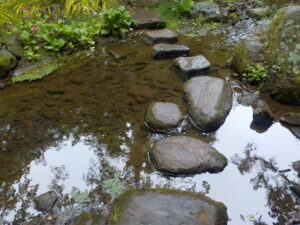
Path crossing water at Chanticleer
All these gardens had significant areas of lawn or meadow. I realize that lawns are not in favor, generally, among the pro-pollinator and bird crowd. But if you provide plenty of plants that support pollinators, I do not see lawns as bad. Each of these gardens has plenty of flowering trees, shrubs, perennials and annuals. Something is always in bloom, including both native plants and exotic ones.
So what does lawn accomplish? It provides contrast – a simple green palette – to show off the plants. Expanses of green are soothing to the eye. I can only focus on so many amazing plants before I get visually fatigued – much as I do when I visit an art museum.
Lawn also allows you to stand back to see the landscape from a distance. For trees, that is important. In a forested area, and all three of these gardens have them, individual trees are sometimes hard to see. They blend in with the others. But I need to stand back to look at a majestic beech or oak that towers 100 feet above me.
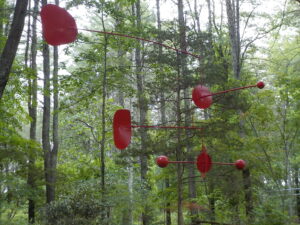
Sculpture in the woods at Bedrock Gardens
Bedrock Garden only recently was deeded over from the original owners, Jill Nooney and Bob Munger, to the non-profit that manages the property. Jill is an amazing sculptor who for over 30 years has created art to surprise and delight visitors to this 20 acre garden. Much of her art is painted welded steel that will delight visitors for the century ahead. She is the modern Alexander Calder of gardens.
Although I am not an artist, I do purchase and create art and whimsy for my own gardens, and you can, too. Look around at what you can use: a brass headboard from an abandoned bed; the rim of an old wagon wheel, a collection of stacked stones or a single tall standing stone buried in the ground. Stone always enhances a garden. Walls are expensive, but almost worth their weight in gold.
Pathways are important to a great garden, too. They lead the visitor from one area to another. Placing art or even a bench at a distance pulls viewers forward, luring them to see what is ahead. Chanticleer has wonderful pathways through the woods that appear to be wood chips embedded in rubber. Very soothing to knees and feet.
My late sister, Ruth Anne Mitchell, taught me long ago when viewing art or gardens that, “If you see a place to sit down, sit down.” So I do, and I find it enhances the experience of the garden. Not only am I less tired, often gardens surprise us with something special near a resting point. Perhaps you can design a special feature near a bench: rare and dainty plants or a small water feature.
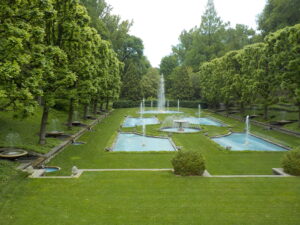
Formal use of lawns and water at Longwood
All three of the gardens I visited made much use of water in the landscape. I am lucky enough to have a small stream that runs by my gardens. I built a bench near it, so I can listen to the burble of the water. And you can tune your brook: Place stones that hold back water, allowing it to cascade over them. Different drops create different sounds.
Years ago, for NY Times article, I interviewed by phone the designer of the gardens at the Getty Museum in Los Angeles, Robert Irwin. He created a recirculating stream that crossed a path through a woodland area seven times. He told me he tuned it so that at each little bridge visitors would hear a different aquatic tune. Think of that if you have a stream on your property.
Color is very important in designing good or great gardens. I only got the 8-color box of crayons as a boy; my sister Ruth Anne got the 64-crayon box. But I have learned to appreciate all the nuances of color and how they go together. The best explanation of how colors go together – or don’t – is a book by garden writer Sydney Eddison: “The Gardener’s Palette: Creating Color in the Garden” (Contemporary Books, 2003, $30 in hardback). Get it if you can find a copy.
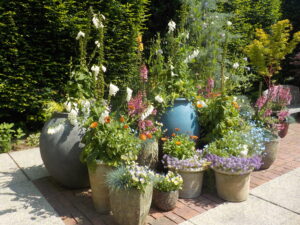
Pots at Longwood
Great gardens like those at Longwood, an old DuPont family residence originally, recognize that color is important all year. But most shrubs and perennials only bloom for a few weeks. So they choose trees and shrubs that are not only sculptural in form, but have also have nuanced colors in their leaves. Green is not one color, but many. Choose wisely.
Lastly, another way to present color all spring, summer and fall is to use annual flowers liberally. Many of these will keep on blooming in an effort to create seeds. Pots of annual flowers are used frequently in these great gardens. Pots place flowers closer to the viewer’s eye and can also be replaced with other pots if the flowers finish their displays or look a bit bedraggled.
So do visit other gardens this summer – whether at a local garden club tour or one of the fine gardens I mentioned here today.
Henry is a garden consultant and the author of 4 gardening books. He speaks often to garden clubs and library groups. Reach him at
henry.homeyer@comcast.net or PO Box 364, Cornish Flat, NH 03746.
During the pandemic they created a parking lot and visitors center that are accessed away from their home, the old farm house they have lived in for over 40 years. They have created a space that is family-friendly that delights children as much as their parents.
Jill Nooney has used plants in ways that surprised me. So for example, she used ‘Bulls Blood’ heritage beets in a flower bed for their deep purple leaves. An annual effort, but very striking. When a hollow tree was cut down, she had Bob cut it in two-foot sections and stack the sections between two trees so viewers walking by could see through it like binoculars. One can see where branches had been swallowed by its growth. They call it “Log Jam.”










